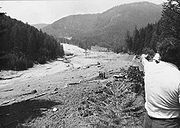
Val di Stava Dam Collapse
Encyclopedia

Tesero
Tesero is a comune in Trentino in the northern Italian region Trentino-Alto Adige/Südtirol, located in the Val di Fiemme about 40 km northeast of Trento...
, Northern Italy
Northern Italy
Northern Italy is a wide cultural, historical and geographical definition, without any administrative usage, used to indicate the northern part of the Italian state, also referred as Settentrione or Alta Italia...
, failed. It resulted in one of Italy's worst disasters, killing 268 people, destroying 63 buildings and demolishing eight bridges.
The upper dam broke first, leading to the collapse of the lower dam. Around 200,000 cubic metres of mud, sand and water were released into the Rio di Stava valley and toward the village of Stava at a speed of 90 km/h. Having crashed through the village, the torrent continued until it reached the Avisio River
Avisio River
The Avisio is a 89,4 km Italian stream , a left tributary of the Adige, whose course is in Trentino.It rises from Marmolada and runs through the Fascia Valley, the Fiemme Valley and the Cembra Valley before joining the Adige in the town of Lavis, a small town 8km northern of Trento....
a further 4.2 km away, destroying everything in its path.
Cause
An investigation into the disaster found that the dams were poorly maintained and the margin of safe operation was very small.A pipe in the upper dam used to drain water had begun to sag under the weight of sediment
Sediment
Sediment is naturally occurring material that is broken down by processes of weathering and erosion, and is subsequently transported by the action of fluids such as wind, water, or ice, and/or by the force of gravity acting on the particle itself....
, making the dam's drainage less effective. Meanwhile, water continued to be pumped into the reservoir behind the dam, which, coupled with the less efficient drainage, meant the pressure on the bank of the upper dam began to increase. Following the path of least resistance
Path of least resistance
The path of least resistance describes the physical or metaphorical pathway that provides the least resistance to forward motion by a given object or entity, among a set of alternative paths. The concept is often used to describe why an object or entity takes a given path.In physics, the path of...
, water began penetrating the bank, causing the soil within to liquefy
Soil liquefaction
Soil liquefaction describes a phenomenon whereby a saturated soil substantially loses strength and stiffness in response to an applied stress, usually earthquake shaking or other sudden change in stress condition, causing it to behave like a liquid....
and weaken the bank until it failed. The water and tailings
Tailings
Tailings, also called mine dumps, slimes, tails, leach residue, or slickens, are the materials left over after the process of separating the valuable fraction from the uneconomic fraction of an ore...
from the upper dam then flowed into the lower dam, which, under the immense pressure produced, failed thirty seconds later.
See also
- List of wars and disasters by death toll: Flood disasters
- National Geographic Seconds From Disaster episodes
- 1998 Residue dam wall collapse of the Aznalcollar mineAznalcollar mineThe Doñana Disaster, also known as the Aznalcollar Disaster or Guadiamar Disaster , was an industrial accident in Andalusia, southern Spain. On 25 April 1998, a holding dam burst at the Los Frailes mine, near Aznalcóllar, Seville Province, releasing 4–5 million cubic metres of mine tailings...
- 2000 Baia Mare cyanide spill2000 Baia Mare cyanide spillThe 2000 Baia Mare cyanide spill was a leak of cyanide near Baia Mare, Romania, into the Someş River by the gold mining company Aurul, a joint-venture of the Australian company Esmeralda Exploration and the Romanian government....
- 2010 Ajka alumina plant accident Ajka alumina plant accidentThe Ajka alumina sludge spill was an industrial accident at a caustic waste reservoir chain of the Ajkai Timföldgyár alumina plant in Ajka, Veszprém County, in western Hungary...

